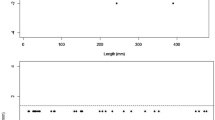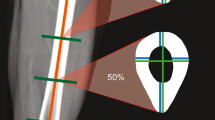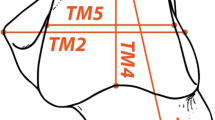Abstract
The discriminant power of bone volume for determining sex has not been possible to determine due to the difficulty in its calculation. At present, new advancements based on 3D technology make it possible to reproduce the bone digitally and calculate its volume using computerized tools, which opens up a new window to ascertaining the discriminant power of this variable. With this objective in mind, the tali and radii of 101 individuals (48 males and 53 females) of a contemporary Spanish reference collection (twentieth century) (EML 1) were scanned using the Picza 3D Laser Scanner. Calculated for the tali were total volume, the volume of the posterior region, which includes the posterior calcaneal facet and other three volumes of the anterior region. Calculated for the radius were total volume, volume of the radius head, volume of the diaphysis, and volume of the distal end. The data are presented for all of the variables, distinguishing between the right and left side. The data were processed using the statistical program PASW Statistics 18, thereby obtaining classification functions for sex which accurately classify 90.9 % of tali and 93.9 % of radii on the basis of their total left and right volume, respectively. Studying the volume in different regions of the bone shows that the diaphysis of the right radius possesses a high level of discriminant power, offering classification functions which accurately classify 96.9 % of the sample. The validation test performed on a sample of 20 individuals from another contemporary Spanish reference collection (EML 2) confirms the high discriminant power of the volume obtaining an accurate classification rate of 80–95 % depending on the variable studied.





Similar content being viewed by others
References
Steel DG (1976) The estimation of sex on the basis of the talus and calcaneus. Am J Phys Anthropol 45:581–588
Gualdi-Russo E (2007) Sex determination from the talus and calcaneus measurements. Forensic Sci Int 17:151–156
Berrizbeitia EL (1989) Sex determination with the head of the radius. J Forensic Sci 34(5):1206–1213
Barrier ILO, L’Abbé EN (2008) Sex determination from the radius and ulna in a modern South African sample. Forensic Sci Int 179:85.e1–85.e7
Machado-Mendoza D, Pablo-Pozo J (2008) Estudio del dimorfismo sexual del radio en europoides cubanos. Rev Esp Antropol Fís 28:81–86
Singh S, Singh SP (1975) Identification of sex from tarsal bones. Acta Anat 93:568–573
Todd TW, Kuenzel W (1925) The estimation of cranial capacity: a comparison of the direct water and seed methods. Am J Phys Anthropol 8(3):251–259
Stewart TD (1934) Cranial capacity studies. Am J Phys Anthropol 23(3):337–361
Uspenskii S (1954) A new method for measuring cranial capacity. Am J Phys Anthropol 22:115–117
Mackinnon L, Kennedy JA, Davies TV (1956) Estimation of skull capacity from roentgenologic measurements. Am J Roentgenol Radium Ther Nucl Med 76(2):303–310
Jorgensen JB, Quaade F (1956) The external cranial volume as an estimate of cranial capacity. Am J Phys Anthropol 14(4):661–664
Kaufman B, David CJ (1972) A method of infracranial volume calculation. Invest Radiol 7:533–538
Olivier G, Tissier H (1975) Determination of cranial capacity in fossil men. Am J Phys Anthropol 43(3):353–362
Mayhew TM, Olsen DR (1991) Magnetic resonance imaging (MRI) and model-fore brain estimates of forebrain volume determined using the Cavalieri principle. J Anat 178:133–144
Steven RL (1992) Cranial capacity evolution in Homo erectus and early Homo sapiens. Am J Phys Anthropol 87(1):1–13
Baab KL, McNulty KP (2008) Size, shape and asymmetry in fossil hominids: the status of the LB1 cranium based on 3D morphometric analyses. J Hum Evol 30:1–15
Lorenzo C, Carretero JM, Arsuaga JL, Gracia A, Martínez I (1998) Intrapopulational body size variation and cranial capacity variation in Middle Pleistocene humans: the Sima de los Huesos sample (Sierra de Atapuerca, Spain). Am J Phys Anthropol 106(1):19–33
Butaric LN, McCarthy RC, Broadfild DC (2010) A preliminary 3D computed tomography study of the human maxillary sinus and nasal cavity. Am J Phys Anthropol 143(3):426–436
Allen JS, Damasio H, Grabowski TJ (2002) Normal neuroanatomical variation in the human brain: An MRI-volumetric study. Am J Phys Anthropol 118(4):341–358
Craig JG, Cody DD, Van Holsbeeck M (2004) The distal femoral and proximal tibial growth plates: MR imaging, three-dimensional modeling and estimation of area and volume. Skeletal Radiol 33:337–344
Cicuttini F, Forbes A, Morris K, Darling S, Bailey M, Stuckey S (1999) Gender differences in knee cartilage volume as measured by magnetic resonance imaging. Osteoarthr Cart 7:265–271
Faber SC, Eckstein F, Lukasz S, Muhlbauer R, Hohe J, Englmeier KH, Reiser M (2001) Gender differences in knee joint cartilage thickness, volume and articular surface areas: assessment with quantitative three-dimensional MR imaging. Skeletal Radiol 30:144–150
Kranioti EF, Nathena D, Michalodimitrakis M (2011) Sex estimation of the Cretan humerus: a digital radiometric study. Int J Legal Med 125:659–667
Hsiao TH, Tsai SM, Chou ST, Pan JY, Tseng YC, Chang HP, Chen HS (2010) Sex determination using discriminant function analysis in children and adolescents: a lateral cephalometric study. Int J Legal Med 124:155–160
Macalauso PJ (2011) Sex discrimination from the glenoid cavity in black South Africans: morphometric analysis of digital photographs. Int J Legal Med 125:773–778
Sholts SB, Wärmländer S, Flores LM, Miller K, Walker PL (2010) Variation in the measurement of cranial volume and surface area using 3D laser scanning technology. J Forensic Sci 55(4):871–875
Pretorius E, Steyn M, Scholtz Y (2006) Investigation into the usability of geometric morphometric analysis in assessment of sexual dimorphism. Am J Phys Anthropol 129:64–70
Bytheway JA, Ross AH (2010) A geometric morphometric approach to sex determination of the human adult os coxa. J Forensic Sci 55(4):859–864
Giancoli DC (1997) Física, principios con aplicaciones. Prentice Hall, Upper Saddle River
Acknowledgments
We thank the Computer Center of Universidad Complutense de Madrid for the availability of the 3D scanner, and we specially thank Pedro Cuesta Álvaro for the revision of the statistical study.
Author information
Authors and Affiliations
Corresponding author
Electronic supplementary materials
Below is the link to the electronic supplementary material.
Fig. 6
Point 1 and point 2 anterior volume 1 (JPEG 132 kb)
Fig. 7
Anterior volume 1 (JPEG 50 kb)
Fig. 8
Point 2 anterior volume 2 and 3 (JPEG 206 kb)
Fig. 9
Point 1 anterior volume 2 (JPEG 225 kb)
Fig. 10
Anterior volume 2 (JPEG 62 kb)
Fig. 11
Point 1 anterior volume 3 (JPEG 235 kb)
Fig. 12
Anterior volume 3 (JPEG 82 kb)
Fig. 13
Point 1 and 2 posterior volume (JPEG 233 kb)
Fig. 14
Posterior volume (JPEG 63 kb)
Fig. 15
Point 1 and 2 head volume (JPEG 216 kb)
Fig. 16
Head volume (JPEG 32 kb)
Fig. 17
Point 1 and 2 distal end volume (JPEG 156 kb)
Fig. 18
Distal end volume (JPEG 32 kb)
Rights and permissions
About this article
Cite this article
Ruiz Mediavilla, E., Perea Pérez, B., Labajo González, E. et al. Determining sex by bone volume from 3D images: discriminating analysis of the tali and radii in a contemporary Spanish reference collection. Int J Legal Med 126, 623–631 (2012). https://doi.org/10.1007/s00414-012-0715-5
Received:
Accepted:
Published:
Issue Date:
DOI: https://doi.org/10.1007/s00414-012-0715-5




